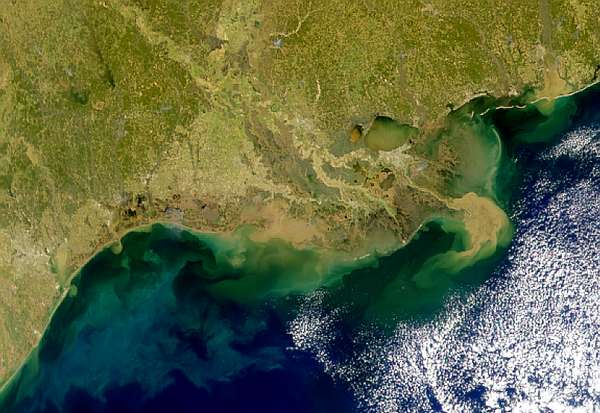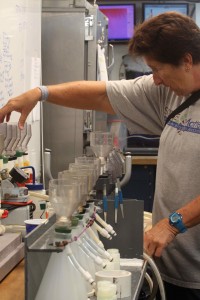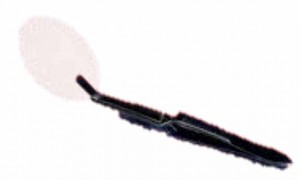Deep Sea Fish and Sediment Surveys in the Gulf
Something is Afoot!: August 11, 2013
Posted by E. McCormack, C-Image Teacher-at-Sea
Water, water everyday!
You might not think that you can tell a lot from a bottle of seawater, but the truth is that one of the most important missions on this cruise has been the collection of water samples. Bylsma and I have spent hours upon hours in the long lab, filtering water and preparing samples that will be run back on dry land for a variety of important measurement. In fact, from each niskin bottle of water collected, nine different measures will be collected and recorded. In this cruise alone, we have taken 143 different water samples across 12 stations at depths ranging from 2 to 2300 meters below the surface. Because scientists have systematically collected these samples over the past three years, we have begun to create a historical database that will allow us to develop a clearer picture of how the Gulf behaves over time.
All of these water samples we collected had to go through a complicated filter setup, and each was prepared following a specific protocol depending on what substances would be measured in the lab. We used a tiny 0.7μm filter, which is small enough to catch the tiny living phytoplankton, while all the dissolved nutrients pass through into the filtrate. One way to think of it is that all the biology gets stuck on the filter and the chemistry passes out in the filtrate! Keeping everything straight was a challenge, but I actually liked figuring out the most efficient way to get it done.
Things that make you go hmmm….
At first, as Sue Murasko, research scientist for Florida Fish & Wildlife and champion for phytoplankton water sampling in the Gulf, showed us the ropes, I’ll admit I was focused on learning the filtering process, and didn’t see much difference between any of the many bottles of water we poured through the filters. However, by the time we started the DSH deep water transect line, Sue got excited and even I noticed that we were getting some funky waters. Instead of the deep blue water we should have been seeing, the water had a greenish tinge (even though it was still mostly clear in the funnel). We noticed a slightly funky smell, and most importantly when you are filtering water in the middle of the night, it took FOREVER for the water to run through our filters! Something was weird out there, and we had a mystery on our hands!
Let’s examine the evidence.
1. The sea had a funny greenish tinge instead of its normal deep blue color.
2. We noticed a funky, fishy smell when we were filtering the water.
3. We should have been able to pour 4 L of water through the filters without a problem, but now the filters for the surface and near surface waters were completely clogged after half that amount and the water just sat there.
4. When we pulled the filters, which normally look clean to the naked eye, they had a brownish tinge.
As Sue said, something was definitely afoot! There had to be some unusual substance in this water big enough to clog the microfilters in the lab, but small enough to pass through the fine mesh we used when we pulled the water from the Niskin bottles.
Putting together the puzzle
At this point, Sue was getting excited and was looking for more pieces of the puzzle. The CTD device measures salinity on every cast, and Sue checks out the readings and finds out that instead of being in the 33-35 ppm range that we expect to find in near surface ocean water, we were looking at a salinity of 25 ppm. To see a change like this, either salt was being sucked out of the system (which doesn’t seem likely), or fresh water was being added.
Rainwater was the first thing that came to my mind sitting out there in the middle of the ocean so far away from any freshwater sources, but thinking it through, I realized it doesn’t work as an explanation. Rainwater can sometimes create a freshwater lens on the very surface of the water, but we were seeing our salinity change well below the surface. Also, we haven’t seen much more rain than scattered showers this past week. Even if it were pouring down, the Gulf is a huge reservoir of water, and to change salinity by 10 parts would require a huge input of freshwater—far more than normal rainstorms could produce.
So Sue asked me what other source of freshwater could we have so far away from land? What river could be big enough to have an effect out here??? Could it really be that the Mississippi is pushing water this far out into the Gulf?
A Working Hypothesis
The Mississippi Plume is where the water and sediments (about 500 million tons) carried by the Mississippi River enter the Gulf. From a satellite, you can see the area where the murky brown water of the river runs into the blue waters of the Gulf, but this usually happens much closer to shore than at the deep water stations that we were sampling. Sue felt that it might be the answer to our mystery, but as any good scientist knows ‘feelings’ aren’t enough to solve a mystery.

Notice where the brown waters of the Mississippi typically mix with the deep blue Gulf waters. The deep water stations we are sampling are usually beyond this region. Credit: Provided by the SeaWiFS Project, NASA/Goddard Space Flight Center, and ORBIMAGE
We were able to add a little more evidence in favor of our plume hypothesis when we started pulling in terrestrial detritus (aka twigs and sticks) from the bongo nets. Where would we be getting sticks from if they weren’t being carried out from land?? Checking in on the news, we found reports of heavy rains in the Midwest, and deadly flash floods in Missouri. All of this water had to feed into the Mississippi River, and eventually flood out into the Gulf.
More Measures Needed
Even though everything so far supports our plume explanation, we still don’t have enough information to accept our hypothesis. Sue will have to run our samples in the lab before we can be comfortable attributing our funky water to the Mississippi plume. We have all the samples we need to get the data to confirm our hypothesis, we just have to run these tests on land as we can’t do it as sea. One of the measures determines the amount of Chlorophyll A contained in the sample. Chlorophyll A is contained within the cells of photosynthetic organisms (out here, we call these guys phytoplankton), and is one of the pigments that allows these primary producers to convert energy from the sun into cellular energy. Measuring Chlorophyll A is a way to estimate how much phytoplankton we have in a system. If our hypothesis is valid, we would expect to see increases in amount chlorophyll from all of the freshwater phytoplankton that would have been swept along by the river.
Dissolved Nutrients
Several of the other measures that we sample for give us an idea of the amount of dissolve nutrients in the Gulf. One of the major goals of the C-Image project is to assess nutrients limitations for phytoplankton in the photic zone, or the part of the water column where light penetrates and photosynthesis occurs.

Jonelle Basso with the CTD. Jonelle's efficient and cheerful management of the water collection system made sure that everyone got their samples.
Phytoplankton require certain key nutrients to survive, and monitoring the concentrations of those nutrients in a system can give us an indication of the health of the system. Limiting nutrients are the essential nutrients that are most often used up in the system, and therefore act as a control on the number of organisms that can survive in that environment. For example, nitrogen in the environment is snapped up by the phytoplankton pretty quickly, meaning that we usually don’t detect much available nitrogen in a sample. Sometimes, however, a system might have an extra input of nitrogen from somewhere, and the limiting nutrient might turn out to be phosphate. Our data would show us that now there was unclaimed nitrogen floating around, but we wouldn’t see any phosphate. Monitoring these nutrients gives us an idea of how matter is cycling through a system, which can be an important clue in assessing the health of the system.
If the Mississippi plume is responsible for our funky water, we should also see a considerable spike in the dissolved nutrients because of the agricultural runoff that would be carried along in the Mississippi. Eventually, we might see increases in populations of plankton and overall biomass because of all of the extra nutrients that have been transported out in the deep water zone. All of this is part of the nutrient cycle, and part of the Gulf system we are working so hard out here to study!
The Most Interesting Water I Have Ever Seen
I feel really lucky I was out here in the Gulf when we had a mystery to solve. Even though the filtering took longer and we had to work a little harder, I feel like I got a chance to see how all of this fits together. I’m so glad I really got to see how fascinating a glass of water really can be!
| Print article | This entry was posted by greely on August 11, 2013 at 5:53 pm, and is filed under Oceanic Updates. Follow any responses to this post through RSS 2.0. You can leave a response or trackback from your own site. |




